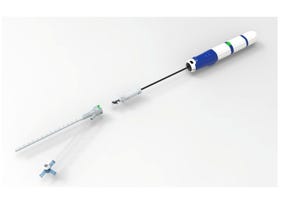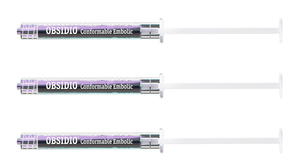An additive manufacturing process, electroplating can be used to manufacture devices used in a host of procedures, including minimally invasive surgeries.
June 2, 2015
Ross Peterson and Craig Ingalls
|
An electroplating process from ProPlate atomically bonds metal directly to each catheter braid–pic crossing, fusing them together. By fusing every strand intersection, the individual strands become monocoque, eliminating the relative slip of strand across strand. |
Historically, electroplating has been used to add a thin layer of a precious metal—typically gold—to an electrical connector to improve corrosion resistance. However, recent collaborations between electroplating professionals and medical device designers have resulted in the development of new applications based on this versatile manufacturing technology. Consequently, from traditional to innovative designs, the medical device industry can benefit from the electroplating process in many ways.
Accomplished by immersing parts in a series of liquid chemistries, the electroplating process is used to coat metals and sometimes plastics with a layer of another metal. Generally, these immersions include one or more cleaning steps, an activation step in which the surface of the part is stripped of its attached oxygen molecules, and a plating step in which the part is electrically charged to attract and attach metal atoms that are dissolved in the plating bath.
An additive manufacturing process, electroplating is performed by building up plating layers measuring as thin as 0.000003 in. at a very slow rate. In a related process known as electroforming, plating layers are built on a disposable or reusable mandrel. When this mandrel is removed, the electroformed part remains behind—a process by which the part is not coated but fabricated from scratch. Thus, electroplating can be used to fabricate entire parts, often many at one time.
How Electroplating Enhances Medical Devices
Electroplating can be employed to enhance medical device functionality in myriad ways. For example, electroplated metals can be used to conduct heat and electricity, offer good wear and corrosion resistance, produce strong welds, create antimicrobial and biocompatible surfaces, and fabricate such device features as radiopaque markers and catheter braiding.
Electroplatable metals such as copper and silver are two of the most thermally conductive metals. Thus, they can be added to medical ablation devices to conduct heat away from the worksite, eliminating tissue burning and adhesion of tissue to the device.
Because metals are good conductors of electricity, electroplating has traditionally been used to create components used in electronic devices. Silver, copper, and gold, respectively, are the three most electrically conductive metals on earth. However, because gold is expensive, it is used sparingly in medical device applications. On the other hand, silver at various thicknesses is relatively inexpensive and can reduce parasitic power consumption by as much as 90% in many applications, increasing battery life in portable devices. And because they offer extremely high electrical conductivity, both silver and copper can be applied continuously or selectively to the surface of a medical device to carry current. Furthermore, during the electroplating process, the geometry of the electrodeposit can be shaped to conform to an optimized dimension set, helping to reduce overall device dimensions.
Electroplating can be used to enhance a device’s wear resistance by codispersing diamond particles with electroless nickel coatings. In addition, because implantable devices are subjected to moist environments inside the body and because the chlorine-infused wipes used to clean many medical devices can deteriorate metal surfaces, manufacturers must consider corrosion resistance during the design process. To achieve corrosion resistance, devices can be electroplated with a range of materials, including rhodium, gold, palladium, and nickel.
Welding dissimilar metals such as stainless steel and nickel titanium can be difficult. However, these metals can be rendered similar by coating their surfaces with a common and weldable material such as nickel or gold. This process can be a cost-effective way to lower the use of such costly alloys as nickel-titanium.
Because both silver and copper are known to have antimicrobial properties, thin layers of these metals can be deposited on the surface of medical devices to prevent infections. Moreover, such layers do not wear off, as do polymer coatings. In addition, silver and gold are biocompatible materials. Because it is an extremely inert metal, gold does not react with body chemistry to form harmful compounds, rendering it suitable for metallic coatings on implantable devices.
Finishing portions of a medical device with a high-density metal such as gold provides a radiopaque region that can be identified using x-ray radiography. Unlike conventional machine marker bands, electroplating can create radiopaque features that are conformal to very complex geometries. In addition, electroplated radiopaque features exhibit tighter tolerances and lower profiles than machined features, while eliminating the risk of marker dislodgment.

Capable of being performed anywhere along a catheter braid shaft or similar device, electroplating can be used to create a radiopaque metal coating that bonds the catheter braid at the atomic level.
Electroplating can also be used to coat the surface of catheter braids in order to mechanically lock the braid intersections together. This process enhances torque transmission from the proximal to the distal end of the catheter, preserves its flexibility, and improves its placement accuracy. It also increases the device’s torque-to-failure level, twistability, pushability, and kink resistance, while enabling doctors to better control radial forces. At the same time, this process minimizes catheter elongation and prevents the braids from unraveling at the ends.
Improving the Medical Device Design Process
Small mechanical design considerations can either support or hinder the electroplating process. For example, substituting one electroplated metal for another can dramatically reduce costs and increase device performance. By the same token, if such simple routines as cutting tool path routings are performed incorrectly, the part can fail at the electroplating stage.
Devices can fail for a variety of reasons: Component parts can separate, welds on dissimilar materials can break, or mechanical crimps can weaken. Employing the electroplating process enables manufacturers to avoid these failure modes. For example, dissimilar metals can be made similar by added a thin electroplated layer to the surface, thereby making the weld more consistent and robust. And crimped joints can be replaced by electroplated joints, creating an atomic-level bond between two different components.
Unfortunately, surface finishing is seldom considered during the design process. Professional electroplaters often receive quotation requests for parts with less than optimal surface finishes. They also view manufacturability considerations differently from other manufacturers, such as precision metal stampers. The stamper might be concerned with achieving a certain radius, while the electroplater will question whether the radius will form a liquid surface-tension drop, making it difficult to rinse.
Because OEM designers frequently do not have comprehensive knowledge of the electroplating process, they should rely on electroplating experts when designing medical device parts. However, the history of the relationship between electroplaters and their customers is filled with stories of poor quality. First, being a chemical process, electroplating requires a high degree of process management. Furthermore, the electroplating industry is composed primarily of small companies that frequently lack the resources and skills necessary for providing the requisite process management capabilities. Thus, medical device manufacturers should review the quality systems in place at prospective electroplating suppliers to determine that they are thorough and—most importantly—that they are in fact being followed.
How Patients Benefit from Electroplating
To reduce hospital stays and control healthcare costs, minimally invasive surgical procedures and correspondingly smaller surgical tools are needed. Patients also benefit from the use of minimally invasive medical devices because they make the surgical experience less traumatic while accelerating recovery times.
As an additive manufacturing process, electroplating can be used to manufacture tools and instruments used in minimally invasive procedures. For example, an electroplated catheter can be employed to accurately and quickly place a device such as a stent or a valve in the body. A valuable tool in the designers toolbox, the electroplating process can therefore provide solutions to many of the challenges confronting medical device designers in today’s difficult healthcare environment.
Ross Peterson is marketing, project manager at Anoka, MN–based ProPlate. Reach him at [email protected].
Craig Ingalls is owner and president of Anoka, MN–based ProPlate. Reach him at [email protected].
To learn more about electroplating, |
You May Also Like



